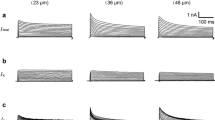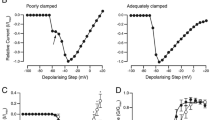Summary
The changes in Na current during development were studied in the dorsal root ganglion (DRG) cells using the whole-cell patch-clamp technique. Cells obtained from rats 1–3 and 5–8 days after birth were cultured and their Na currents were compared. On top of the two types of Na currents reported in these cells (fast-FA current and slow-S current) a new fast current was found (FN). The main characteristics of the three currents are: (i) The voltages of activation are −37, −36, and −23 mV for the FN, FA and S currents, respectively. (ii) The activation and inactivation kinetics of FN and FA currents are about five times faster than those of the S current. (iii) The voltages at which inactivation reaches 50% are −139, −75 and −23 mV for the FN, FA and S currents, respectively.
The kinetics and voltage-dependent parameters of the three currents and their density do not change during the first eight days after birth. However, their relative frequency in the cells changes. In the 1–3 day-old rats the precent of cells with S, FA, and mixed S+FN currents is 22, 18, and 60% of the cells, respectively. In the 5–8 day-old, the percent of cells with S, FA, and FN+S is 10, 66 and 22%. The relative increase in the frequency of cells with FA current during development can contribute to the ease of action potential generation compared with cells with FN currents, which are almost completely inactivated under physiological conditions. The predominance of FA cells also results in a significant decrease in the relative frequency of cells with the high-threshold, slow current.
Antibodies directed against a part of the S4 region of internal repeat I of the sodium channel (C +1 , amino acids 210–223, eel channel numbering) were found to shift the voltage dependence of FA current inactivation (but not of FN or S currents) to more negative potentials. The effect was found only when the antibodies were applied externally. The results suggest that FN, FA and S types of Na currents are generated by channels, which are different in the topography of the C +1 region in the membrane.
Similar content being viewed by others
References
Aldrich, R.W., Corey, D.P., Stevens, C.F. 1983. A reinterpretation of mammalian sodium channel gating based on single channel recording.Nature (London) 306:436–441
Almers, W., McClesky, E.W. 1984. Non-selective conductance in calcium channels of frog muscle: Calcium selectivity in single-file pore.J. Physiol. (London) 353:585–608
Armstrong, C. 1981. Sodium currents and gating currents.Physiol. Rev. 61:644–683
Barchi, R.L. 1988. Probing the molecular structure of the voltage dependent sodium channel.Annu. Rev. Neurosci. 11:455–489
Bossu, J.L., Feltz, A. 1984. Patch-clamp study of the tetrodotoxin-resistent sodium current in group C sensory neurons.Neurosci. Lett. 51:241–246
Catterall, W.A. 1988. Structure and function of voltage sensitive ion channels.Science 242:50–61
Drews, G., Rack, M. 1988. Modification of sodium and gating currents by amino group specific cross-linking and monofunctional reagents.Biophys. J. 54:383–391
Edgar, D., Bard, Y.A., Thoenen, H. 1981. Subpopulations of cultured sympathetic neurons differ in their requirements for survival factors.Nature (London) 289:294–295
Fedlova, S.A., Kostyuk, P.G., Vaselovsky, N.S. 1985. Two types of calcium currents in the somatic membrane of newborn rat dorsal root ganglion neurons.J. Physiol. (London) 359:431–446
Gilly, W.F., Brismar, T. 1989. Properties of appropriately and inappropriately expressed sodium channel in squid giant axons and its somata.J. Neurosci. 9:1362–1374
Gordon, D., Catterall, W.A. 1987. Identification of an intracellular domain of the sodium channel having multiple c-AMP dependent phosphorylation sites.J. Biol. Chem. 262:17530–17535
Gordon, D., Merrick, D., Auld, V., Dunn, R., Goldin, A.L., Davidson, N., Catterall, W.A. 1987. Tissue specific expression of the RI and RII sodium channel subtypes.Proc. Natl. Acad. Sci. USA 84:308–313
Gordon, R.D., Fieles, W.E., Schotland, D.L., Hogue-Angeletti, R., Barchi, R.L. 1987. Topographical localization of the C-terminal region of the voltage dependent sodium channel fromElectrophorus electricus using antibodies raised against a synthetic peptide.Proc. Natl. Acad. Sci. USA 84:308–313
Gordon, R.D., Li, Y., Fieles, W.E., Schotland, D.L., Barchi, R.L. 1988. Topological localization of a segment of the eel voltage dependent sodium channel primary sequence (AA927-938) that discriminates models of tertiary structure.J. Neurosci. 8:3742–3749
Gottman, K., Dietzel, I.D., Lux, H.D., Huck, S., Rohrer, H. 1988. Development of inward currents in chick sensory and autonomic neuronal precursor cells in culture.J. Neurosci. 8:3722–3733
Guyton, A.C. 1981. Medical Physiology. Chap. 48. pp. 595. Sounders, Philadelphia
Hamill, O.P., Marty, A., Neher, E., Sakman, B., Sigworth, F.J. 1981. Improved patch clamp techniques for high-resolution current recording from cells and cell-free membrane patches.Pfluegers Arch. 391:85–100
Harper, A.A., Lawson, J.N. 1985. Conduction velocities related to morphological cell type in rat dorsal root ganglia.J. Physiol. (London) 359:31–46
Harper, A.A., Lawson, J.N. 1985. Electrical properties of dorsal root ganglion neurons with different peripheral nerve conduction velocities.J. Physiol. (London) 359:47–63
Hess, P., Lansman, J.B., Tsien, R.W. 1986. Calcium channel selectivity for divalent and monovalent cations.J. Gen. Physiol. 88:293–319
Heyer, E.J., Mcdonald, R.L. 1982. Calcium and sodium dependent action potentials of mouse spinal cord and dorsal root ganglion neurons in cell culture.J. Neurophysiol. 47:641–655
Hille, B. 1984. Ionic Currents of Excitable Membrane. Sinauer, Sunderland (MA)
Hille, B., Woodhull, A.M., Shapiro, B.I. 1975. Negative surface charge near sodium currents of nerve: Divalent ions, monovalent ions and pH.Phil. Trans. R. Soc. London B 270:301–318
Hodgkin, A.L., Huxley, A.F. 1952. A quantitative description of membrane currents and its application to conduction and excitation in nerve.J. Physiol. (London) 117:500–544
Huang, J.M.C., Tanguy, J., Yeh, J.Z. 1987. Removal of sodium inactivation and block of sodium channels by chloramine-T in crayfish and squid giant axons.Biophys. J. 52:155–163
Ikeda, S.R., Schofield, G.G. 1987. Tetrodotoxin resistant sodium current at nodose neurons; monovalent cation selectivity and divalent cation block.J. Physiol. (London) 389:255–270
Kameyama, M., Hofmann, F., Trautwein, W. 1985. On the mechanism of beta-adrenergic regulation of the Ca channel in the guinea-pig heart.Pfuegers Arch. 405:285–293
Kayano, T., Noda, M., Flockerzi, V., Takahashi, H., Numa, S. 1988. Primary structure of rat brain sodium channel III deduced from the cDNA sequence.FEBS Lett. 228:187–194
Kostyuk, P.G., Shuba, Ya.M., Savahenko, A.N. 1988. Three types of calcium currents in the membrane of mouse sensory neurons.Pfluegers Arch. 411:661–669
Kostyuk, P.G., Vaselovsky, N.S., Tsynderenko, A.Y. 1981. Ionic currents in the somatic membrane of the rat dorsal root ganglion neurons. I. Sodium currents. II. Calcium currents.Neuroscience 6:2423–2438
Krafte, D.S., Snutch, T.P., Leonard, J.P., Davidson, N., Lester, H.A. 1988. Evidence for the involvement of more than one mRNA species in controlling the inactivation process of rat and rabbit brain Na channels expressed inXenopus oocytes.J. Neurosci. 8:2859–2868
Lee, K.S., Akaike, N., Brown, A.M. 1977. Trypsin inhibits the action of tetrodotoxin on neurons.Nature (London) 265:751–753
Lucas, J.H., Gross, G.W., Tramp, B.F., Balentine, J.D., Berezesky, I.K., Young, W., Gilad, G.M., Bernstein, J.S. 1988. Cellular and molecular correlates of central nervous system trauma.J. Neurotrauma 5:209–258
Matsuda, Y., Yoshida, S., Yonezawa, T. 1978. Tetrodotoxin sensitivity and calcium component of action potentials of mouse dorsal root ganglion cell cultured in-vitro.Brain Res. 154:69–82
McLean, M.J., Bennet, P.B., Thomas, R.M. 1988. Subtypes of dorsal root ganglion neurons based on different inward currents as measured by whole cell voltage clamp.Molec. Cell. Biochem. 80:95–107
Meiri, H., Omri, G., Zeitoun, I., Savion, N. 1986. Environmental factors that influence the differentiation and the development of voltage dependent sodium channels in cultured dorsal root ganglion cells of newborn rats.Exp. Brain Res. 13:231–245
Meiri, H., Sammar, M., Schwartz, A. 1989. Production and use of synthetic peptide antibodies to map a region associated with sodium channel inactivation.Methods Enzymol. 178:714–739
Meiri, H., Spira, G., Sammar, M., Namir, M., Schwartz, A., Komoriya, A., Kosower, E.M., Palti, Y. 1987. Mapping a region associated with Na channel inactivation using antibodies to synthetic peptide corresponding to a part of the channel.Proc. Natl. Acad. Sci. USA 84:5058–5062
Merrifield, R.B. 1965. Solid phase synthesis.Science 150:178–185
Messner, D.J., Feller, D.J., Scheuer, T., Catterall, W.A. 1986. Functional properties of rat brain sodium channel lacking the beta1 or beta2 subunits.J. Biol. Chem. 26:14882–14890
Meves, H., Rubly, N., Stampfli, R. 1988. The action of arginine-specific reagents on ionic and gating currents of frog myelinated nerve.Biochem. Biophys. Acta. 943:1–12
Noda, M., Ikeda, T., Kayano, T., Suzuki, H., Takashima, H., Kuraski, M., Takahashi, H., Nakayama, H., Numa, S. 1986. Existence of distinct sodium channel messenger RNAs in rat brain.Nature (London) 320:188–192
Noda, M., Shimizu, S., Tannabe, T., Takai, T., Kayano, T., Ikeda, T., Takahashi, H., Nakayama, H., Kanaoka, Y., Miniamino, N., Kangawa, K., Matsuo, H., Raftery, M.A., Miyata, T., Numa, S. 1984. Primary structure of electrophorus sodium channel deduced from c-DNA sequence.Nature (London) 312:121–127
O'Dowd, D.K., Ribera, A.B., Spitzer, N.C. 1987. Development of voltage-dependent calcium, sodium and potassium currents inXenopus spinal neurons.J. Neurosci.,8:792–805
Okun, L.M. 1972. Isolated dorsal root ganglion neurons in culture: Cytological maturation and extension of electrically active processes.J. Neurobiol. 3:111–151
Omri, G., Meiri, H. 1990. Characterization of sodium currents in mammalian sensory neurons cultured in serum-free defined medium with and without NGF.J. Membrane Biol. 115:13–29
Orozco, C.B., Epstein, C.J., Rapoport, S.I. 1988. Voltage activated sodium conductance in cultured normal and trisomy-16 dorsal root ganglion neurons from fetal mouse.Dev. Brain Res. 3:265–274
Oxford, G.S. 1978. Removal of sodium channel inactivation in squid giant axons by N-bromoacetamide.J. Gen. Physiol. 71:227–247
Palti, Y., Cohen-Armon, M. 1982. Numerical method for correcting the series resistance error in voltage clamp experiments.Isr. J. Med. Sci. 18:19–24
Papazian, D.M., Schwartz, T.L., Temple, B.L., Jan, Y.N., Jan, L.Y. 1984. Cloning of genomic and complimentary DNA from shaker a putative potassium channel gene fromDrosophila.Science 237:749–753
Purves, D., Lichtman, J.W. 1985. Principles of Neuronal Development, Chapter 7. Trophic effects of targets on neurons. pp. 155–178. Sinauer, Sunderland (MA)
Rojas, E., Rudy, B. 1976. Destructive of the sodium conductance inactivation by a specific protease in perfused nerve fibers fromLoligo.J. Physiol. (London) 262:501–531
Sackmann, B., Methfessel, C., Mishina, M., Takahashi, T., Takai, T., Kuraski, M., Fukuda, K., Numa, S. 1985. Role of acetycholine receptor subunits in gating of the channel.Nature (London) 318:538–543
Schmidt, J., Rossie, S., Catterall, W.A. 1985. A large intracellular pool of inactive Na channel alpha subunits in developing rat brain.Proc. Natl. Acad. Sci. USA 82:4847–4851
Scott, B.S., Edwards, B.A.V. 1980. Electric membrane properties of adult mouse DRG neurons and the effect of culturing duration.J. Neurobiol. 11:291–301
Spalding, B.C. 1980. Properties of toxin resistant sodium channels produced by chemical modification in frog skeletal muscles.J. Physiol. (London) 305:485–500
Spitzer, N.C. 1979. Ion channels in development.Annu. Rev. Neurosci. 2:363–397
Stolc, S., Nemcek, V., Boska, D. 1988. Potential clamp of isolated dialyzed neuron: Minimalization of the effect of series resistance.Gen. Physiol. Biophys. 7:303–312
Stuhmer, W., Conti, F., Suzuki, H., Wang, X., Wang, X., Noda, M., Numa, S. 1989. Structural parts involved in activation and inactivation of the sodium channel.Nature (London) 339:597–603
Tanabe, T., Takeshima, H., Mikawi, A., Flocherzi, V., Takahashi, H., Kangawa, K., Kayima, M., Matsuo, H., Hirose, T., Numa, S. 1987. Primary structure of the receptor for calcium channel blockers from skeletal muscle.Nature (London) 328:313–318
Trimmer, S., Jr., Cooperman, S.S., Tomiko, S.A., Zhou, J., Crean, S.M., Boyk, M.B., Galle, R.G., Sheng, Z., Barchi, R.L., Sigworth, F.J., Goodman, R.H., Agnew, W.S., Mandel, G. 1989. Primary structure and functional expression of a mammalian skeletal muscle sodium channel.Neuron 3:33–49
Vassilev, P.M., Scheur, T., Catterall, W.A. 1988. Identification of an intracellular peptide segment involved in sodium channel inactivation.Science 241:1658–1661
Weiss, R.E., Horn, R. 1986. Functional differences between two classes of sodium currents in developing rat skeletal muscle.Science 233:361–364
Yoshida, S., Matsuda, Y., Samejima, A. 1978. Tetrodotoxin-resistant sodium and calcium component, of action potentials in DRG cells of the adult mouse.J. Neurophysiol. 41:1096–1106
Zeitoun, I., Meiri, H., Omri, G., Palti, Y. 1987. The development of different types of Na channels in rat DRG cells.Proc. Int. Biophys. Cong. 9:143
Author information
Authors and Affiliations
Rights and permissions
About this article
Cite this article
Schwartz, A., Palti, Y. & Meiri, H. Structural and developmental differences between three types of Na channels in dorsal root ganglion cells of newborn rats. J. Membrain Biol. 116, 117–128 (1990). https://doi.org/10.1007/BF01868670
Received:
Revised:
Issue Date:
DOI: https://doi.org/10.1007/BF01868670




